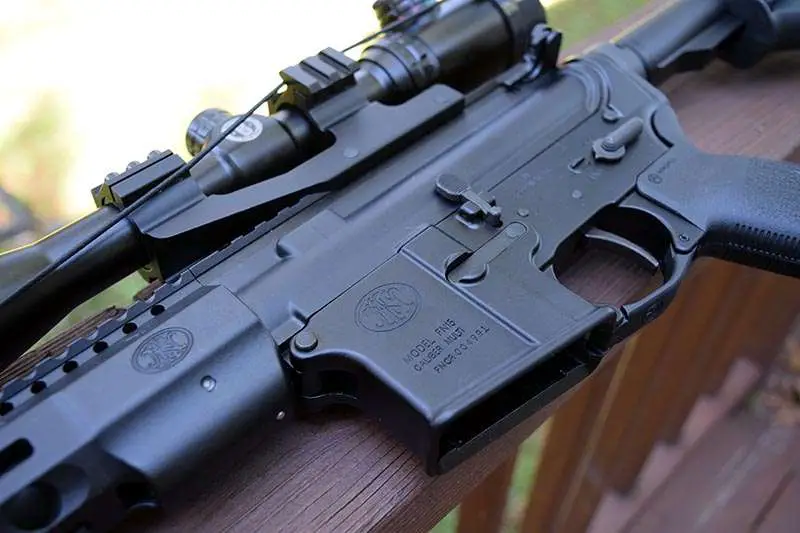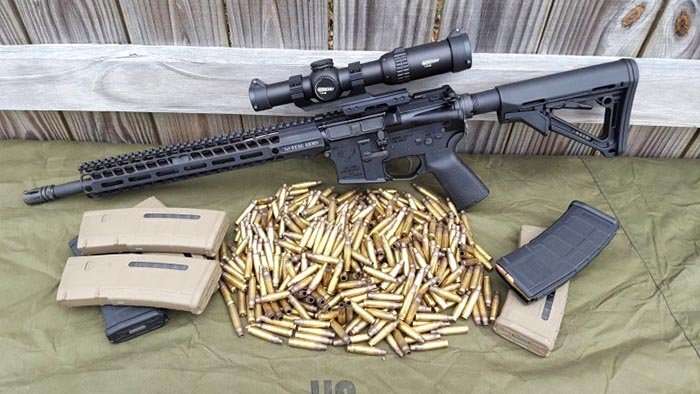
223 Remington
The 223 Remington is a centerfire rifle cartridge that is a .22″ caliber, rimless, bottleneck cartridge case design that can be reloaded. Rifles chambered in this round have a barrel bore land to land diameter of .219″ and a bore groove to groove diameter of .224″.
The 223 Remington was introduced to the public as a commercial cartridge by Remington in January 1964 chambered in their Remington Model 700 bolt action rifle. One month later in February 1964 this same cartridge was officially standardized by the U.S. military as the 5.56mm ball cartridge M193 and is used in AR15’s, M16’s and M4 rifles.
Several years later this cartridge was accepted by NATO as the 5.56×45 NATO cartridge. Many years of testing and development were required to produce this cartridge, the actual name .223 Remington was given to this cartridge in 1959. Prior to 1959, this cartridge was known as the .222 Special.
223 Remington Ballistics:
This first 223 Remington ballistics chart is for 45 grain Remington UMC with a ballistic coefficient of .173. Rifle zero is 100 yards:
| Muzzle | 100 YDS | 200 YDS | 300 YDS | |
| Velocity (FPS) | 3550 | 2953 | 2430 | 1963 |
| Energy (FT/LB) | 1259 | 871 | 590 | 385 |
| Drop (Inches) | -0.3 | 0 | -2.5 | -11.1 |
This next 223 Remington Ballistics chart is for 55 grain Federal American Eagle with a ballistic coefficient of .269. Rifle zero is 100 yards:
| Muzzle | 100 YDS | 200 YDS | 300 YDS | |
| Velocity (FPS) | 3240 | 2874 | 2536 | 2222 |
| Energy (FT/LB) | 1282 | 1008 | 785 | 603 |
| Drop (Inches) | -0.3 | 0 | -2.7 | -10.9 |
This final .223 Remington ballistic table is for 62 grain Hornady Black with a ballistic coefficient of .274. Rifle zero is 100 yards.
| Muzzle | 100 YDS | 200 YDS | 300 YDS | |
| Velocity (FPS) | 3100 | 2751 | 2428 | 2127 |
| Energy (FT/LB) | 1323 | 1042 | 811 | 623 |
| Drop (Inches) | -1.5 | 1.6 | 0 | -7.5 |
.223 Rifles:

Rifles like the pictured AR-15 made by FN Herstal, come chambered in several different calibers. One of the most popular is the 5.56 NATO, which is also capable of accurately and safely firing the .223 Remington. There are also rifles chambered in .223 Remington, but they’re not recommended to shoot the higher pressure 5.56.
.223 Remington and 5.56 NATO are also popular chamberings for bolt action rifles, Mini 14 rifles, and even lever action rifles.
223 Remington Uses:
The 223 Remington is one of the top varmint and predator rounds in the United States. The 223 Remington is a light recoiling cartridge, easy to reload, and fun to shoot. And in fact, the 223 is at the top of the charts in terms of sales.
There are so many variations of rifle action types, rifling twist rates, surplus ammo, range brass, bulk bullets, that the .223 Remington will remain at the top of the sales charts for a very long time.
With so many states allowing .22″ caliber centerfire rifle cartridges for medium-size game hunting, there are more 223 options than ever before to make sure the hunter is effective.
These loads seem to work more than adequately out to 100 yards for thin skinned big game animals such as whitetail deer which overall adds to the versatility of 223 Remington chambered rifles.

Deer
The 223 Remington is a popular deer hunting cartridge in states where allowed.

Varmint/Predator
223 Remington is a popular cartridge for varmint and predator control, like coyotes.

Hog
The 223 is a popular hog cartridge, but it’s important to use the right ammo.
.223 Remington for self-defense:

223 is an ideal self-defense cartridge
A clear choice for many different disciplines, the 223 Remington is both popular and abundant. When talking about self-defense, home-defense, or country defense, the .223 and 5.56 NATO are where it’s at. Most of the rifles chambered in these calibers are the AR-15, which are suitable for most types of defense. My home-defense strategy employs an AR-15 because of how well it performs in that role.
Conclusion:
The 223 Remington is a great dual purpose cartridge in that you can use it to bring home dinner and use it to defend yourself.



